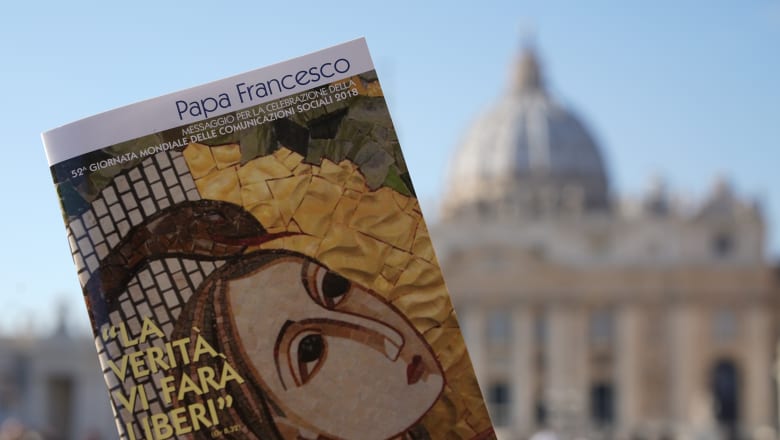By Jason Horowitz
Rome: The serpent in the Garden of Eden hissed the first fake news to Eve and it all went downhill from there, Pope Francis writes in a major document about the phenomenon of fake news released on Wednesday.
"We need to unmask what could be called the 'snake-tactics' used by those who disguise themselves in order to strike at any time and place," the pope writes in a message ahead of what the church has designated as its World Day of Social Communications, in May.
Arguing that the "crafty" serpent's effective disinformation campaign to get Eve to eat from the tree of knowledge "began the tragic history of human sin," he adds, "I would like to contribute to our shared commitment to stemming the spread of fake news."
Pope Francis has worn many hats since his election in 2013 — Vatican reformer; global advocate for refugees, the poor, and world peace; and, more recently, defender of bishops accused of covering up for pedophile priests.
But in a varyingly sophisticated, spiritual and questionable analysis of the fake news epidemic, the 81-year-old pontiff tried on the cap of contemporary media critic to address an issue that has wreaked havoc and undermined democracies from the United States to Europe and beyond.
In doing so, he offered a largely cleareyed assessment of the problem, its social impact, and the responsibility of social media giants and journalists. And he called on news consumers to break out of their comfortable echo chambers and cushy news feeds by seeking out different points of view.

Pope Francis' book on "Fake News" in front of St Peter's Basilica in Rome.
Photo: AP
He also failed to mention the political leaders who have used the phrase to discredit journalists and to dismiss inconvenient reporting.
Betraying a somewhat antiquated view that separates dead-tree and digital outlets, the pope defined fake news as the spreading "online or in the traditional media" of disinformation that is intended to deceive and manipulate consumers for political and economic interests.
He observed that fake news is effective because, like the snake in the garden, it insidiously mimics real news, and is "captious"— pope for clickbait — meaning that it grabs people's attention by exploiting "emotions like anxiety, contempt, anger and frustration."
Francis identified social networks as the delivery systems for such fake news.
"Untrue stories can spread so quickly that even authoritative denials fail to contain the damage," he writes, adding that those living virtual lives in like-minded silos allow disinformation to thrive and that the absence of opposing viewpoints turns people into "unwilling accomplices in spreading biased and baseless ideas."
Russian hackers took advantage of just such conditions in the 2016 American elections, sowing discord and attempting to sway the electorate through sophisticated influence campaigns. Francis steered clear of such real-world examples. Instead, he broadly identified greed as a key engine for the spread of fake news.
"Fake news often goes viral, spreading so fast that it is hard to stop, not because of the sense of sharing that inspires the social media, but because it appeals to the insatiable greed so easily aroused in human beings," he wrote.
The results, he says, are soul-killing.
Turning to the "The Brothers Karamazov," he quotes Dostoyevsky: "People who lie to themselves and listen to their own lie come to such a pass that they cannot distinguish the truth within them, or around them, and so lose all respect for themselves and for others." This leads to the coarsening of society, Francis says.
To combat fake news, the pope called for personal efforts to unmask disinformation, but he also praised educational programs, regulatory efforts and social media companies' progress in verifying personal identities "concealed behind millions of digital profiles."
In recent years, the European Union and several European countries have established offices to combat fake news — this week, Britain became the latest. And fake news has emerged as a major theme in the Italian elections scheduled for March 4, and it is often discussed in the Italian news media that imbues the Vatican.
The speaker of the lower house of the Italian Parliament, Laura Boldrini, has backed a program in Italian public schools to teach children how to identify fake news. The government announced this month an online service through the country's postal police that would respond to, and assess, accusations of fake news.
Likewise, Matteo Renzi, the leader of Italy's governing Democratic Party, has pressed Facebook to monitor its platform for fake news. Facebook has said it would dispatch a task force to address the problem before the Italian election.
Globally, Facebook's more consequential contribution may be a major policy change announced this month: It plans to step back from its de facto role as the world's news publisher. In the United States, more lawmakers are interested in regulating social media giants as they do traditional television broadcasters.
But the pope argues that the most "radical antidote" to the scourge of fake news lies in "purification by the truth." In Christianity, he said, that means living the truth through faith in Jesus, who, he observed, said, "I am the truth" and "the truth will set you free."
Along those lines, he argued that the marshaling of undeniable facts to hurt and discredit others "is not truthful." Nor is any statement that provokes quarrels, division or resignation, he says. The truth, in the pope's reading, leads to dialogue and "fruitful results."
To achieve a climate of open-minded dialogue, Francis exalted journalists, who have been generally demonized by President Trump and other leaders in efforts to undercut critical coverage. The pope called them the "protectors of news" and characterised their profession as a "mission."
"Informing others means forming others; it means being in touch with people's lives," he wrote. "That is why ensuring the accuracy of sources and protecting communication are real means of promoting goodness, generating trust, and opening the way to communion and peace."
That message — and his appeal to cover the powerless, voiceless and downtrodden — could be found in many a Journalism 101 class. Less so his distaste for the "mad rush for a scoop" and focus on "audience impact" and "breaking news."
Also, the value on revelations that the pope seems to think is overemphasised is what many journalists would argue is the greatest service the profession can provide to the powerless, as in the case of Vatican sex abuse and financial scandals.
As the pope sees it, journalists less focused on scoops, news consumers more open to other views, and social media companies and officials more committed to safeguarding the web would open eyes to mimicry — what Francis called "that sly and dangerous form of seduction that worms its way into the heart with false and alluring arguments"— and thus cast that original and slithering bearer of fake news from the garden.
....
Taken from: https://www.brisbanetimes.com.au/world/europe/pope-francis-lays-out-moral-case-against-fake-news-propaganda-20180125-p4yyuk.html
....
Taken from: https://www.brisbanetimes.com.au/world/europe/pope-francis-lays-out-moral-case-against-fake-news-propaganda-20180125-p4yyuk.html



